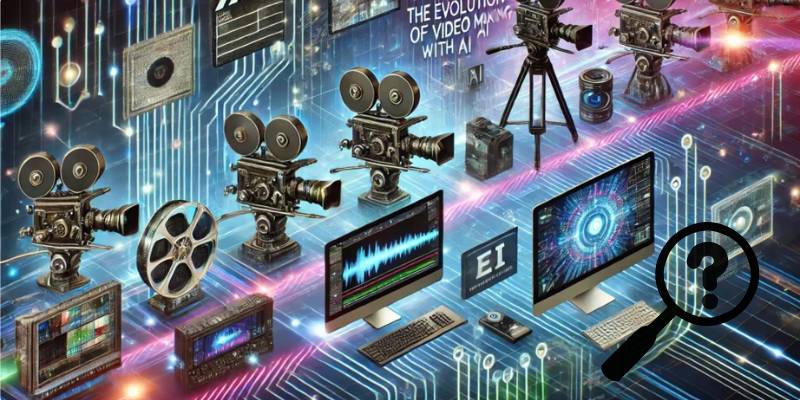When was the last time you watched a slick product demo, a polished explainer video, or one of those “talking head” training clips?
Chances are, you didn’t think twice about what went into producing it. But behind the scenes, video production costs can be astronomical.
For startups—scrappy, lean, constantly balancing growth with survival—that kind of money often isn’t available.
So they’ve historically had two choices: skip video altogether, or blow a big chunk of budget on something they can’t easily scale.
But things are changing. AI-generated video tools are flipping the economics on their head.
Suddenly, the little guy can afford what once was reserved for Fortune 500s. And to me, that shift is nothing short of revolutionary.
A World of High Costs and High Barriers
Let’s rewind for a moment. Traditional video production is expensive for several reasons:
- You need talent—actors, presenters, or voiceover artists.
- You need equipment—cameras, lighting, sound recording.
- You need editing—post-production teams, animation specialists, sometimes even entire agencies.
According to a 2021 survey by Wyzowl, the average corporate explainer video can cost anywhere between $3,000 and $10,000 for just one to three minutes of content.
And that’s before considering revisions, localization for different languages, or updates when the product changes.
For a startup, those video production costs can eat half the marketing budget in a single campaign.
So most of them simply didn’t bother—or they cut corners and produced something that looked amateurish.
Enter AI Video Generation
Now, tools powered by machine learning are changing the game. Want a professional-looking presenter without hiring an actor? AI can generate a lifelike avatar.
Need subtitles or dubbing in five languages? AI handles that in seconds. Want a polished training video for your employees, but don’t have a studio? AI assembles it with text input.
Here’s where the math gets interesting: instead of spending $5,000 on a single corporate video, startups are now producing the same type of content for a few hundred dollars—or less—with affordable AI software like Synthesia, Pictory, and Runway.
The difference isn’t just cost. It’s speed. What once took weeks can now be done in a few hours.
For fast-moving startups, that speed can mean the difference between seizing a market opportunity and watching a competitor take it.
Why Startups Are Leaning In
I’ve spoken with founders who’ve embraced this shift, and a few patterns keep coming up:
- Scalability: Once you’ve got the AI pipeline set up, you can produce dozens of videos quickly, whether they’re ads, tutorials, or investor updates.
- Accessibility: You don’t need a background in filmmaking. A marketing manager with basic copywriting skills can generate content.
- Localization: For startups eyeing international markets, AI makes translation and lip-syncing affordable.
- Consistency: The look and feel remain professional without fluctuating depending on which freelance videographer is available.
The bottom line? It’s not just about saving money. It’s about finally competing on the same playing field as much bigger rivals.
Case Study: Low-Budget Training Videos
Training new employees is one of the least glamorous but most expensive parts of running a business.
You either bring in trainers repeatedly, or you make a library of training materials. Traditionally, that meant hiring production crews to film scenario-based clips or corporate presentations.
Now, startups are creating low-budget training videos with AI avatars explaining compliance rules, onboarding steps, or even software walk-throughs.
A friend of mine runs a small logistics startup. He told me that before AI, onboarding a single class of warehouse employees cost them nearly $15,000 annually in video production and training sessions.
After switching to AI-generated training videos, they brought that cost down to under $2,000.
The kicker? Employee engagement scores actually went up, because the videos could be refreshed more often and tailored more closely to their roles.
It’s stories like this that make me believe AI isn’t just a cost-saver. It’s an equalizer.
Marketing on a Shoestring: AI for Small Business Marketing
Another huge area of savings? Marketing.
Startups don’t have Super Bowl ad budgets. They’re often running Facebook ads with just a few hundred dollars behind them.
But thanks to AI for small business marketing, even these campaigns can now look polished and professional.
Imagine being able to spin up product demos, customer testimonials (using avatars), or animated explainer videos that look like they cost tens of thousands of dollars, but were actually created by one person sitting at a laptop. That levels the playing field in a way we’ve never seen before.
And here’s something interesting: small businesses using video in their marketing see 34% higher conversion rates compared to those that don’t, according to a 2022 HubSpot report.
With AI making video cheaper, more startups can finally harness those benefits without going broke.
The Emotional Side of the Shift
Now, let me pause on the numbers for a second and talk about how this feels.
Startups often live in survival mode. Every expense has to be justified. Every mistake could be fatal. For founders, the pressure can be crushing.
So when AI tools open a door that was once locked by cost, it doesn’t just change the marketing strategy—it changes the psychology of running the business.
Suddenly, they can experiment. They can test campaigns. They can afford to fail and try again, because each attempt doesn’t cost thousands.
That freedom to iterate, emotionally, is priceless.
Are There Downsides? Of Course
I’d be lying if I said this was all sunshine. There are real risks.
- Homogenization: If everyone uses the same avatars and templates, will videos start to look generic?
- Authenticity: Consumers are smart. Will they feel duped by AI presenters instead of real people?
- Ethical questions: What if AI-generated avatars are misused—say, to impersonate someone without consent?
- Job disruption: Professional videographers, editors, and actors could lose work as startups turn to AI.
These aren’t small concerns. They’re worth grappling with. But in my view, the upside for startups outweighs the risks—especially when the alternative is being priced out of video entirely.
Global Accessibility and Inclusivity
Another thing I love about AI video? Its potential for inclusivity.
AI can generate subtitles instantly, create sign-language overlays, or produce voiceovers in dozens of languages. That means startups can reach audiences they simply couldn’t before.
For example, a health-tech startup in India recently produced patient education videos in 10 different regional languages—something that would’ve been financially impossible with traditional crews. The AI made it happen in a fraction of the time and cost.
Inclusivity, in this sense, isn’t just a nice-to-have. It’s a growth strategy.
The Future: Where This Is Headed
So, where do we go from here?
I suspect we’ll see AI video becoming standard, not just for startups but for mid-sized companies and eventually even individuals.
Imagine a world where anyone can generate a high-quality video resume, a personalized investor pitch, or a product launch clip with almost no budget.
At the same time, I think we’ll also see a cultural shift: as audiences become used to AI video, authenticity will be valued even more.
Some startups will use AI for scale, but sprinkle in human-led, authentic content to build trust. The winners will be those who find the right balance.
Solutions and Safeguards
If you’re a startup considering AI video, here are a few guidelines I’d suggest:
- Mix AI with human touches: Don’t make everything AI-generated. Show your real team sometimes.
- Stay transparent: If you’re using avatars, let viewers know. Honesty builds trust.
- Focus on storytelling: AI can polish the visuals, but the narrative still has to connect emotionally.
- Keep experimenting: The low costs mean you can afford to test. Use that flexibility to your advantage.
My Personal Take
I’ll be honest. As someone who once worked with a startup that blew $8,000 on a three-minute video they never used, I can’t help but cheer for this new world.
Yes, I worry about the ethics. Yes, I worry about creative professionals losing work. But I also know how hard it is to build something from scratch, and how heartbreaking it is when a great idea fails simply because the team couldn’t afford basic marketing.
AI video feels like a lifeline for those dreamers. And in a business landscape where startups drive so much innovation, I think that lifeline matters.
Closing Thought
The story of AI video isn’t just about saving money. It’s about rewriting the rules of who gets to tell their story.
For the first time, the ability to produce high-quality, professional-looking video is no longer locked behind big budgets and big studios.
Startups are saving millions, yes. But more importantly, they’re gaining a voice. And that might be the most powerful outcome of all.


